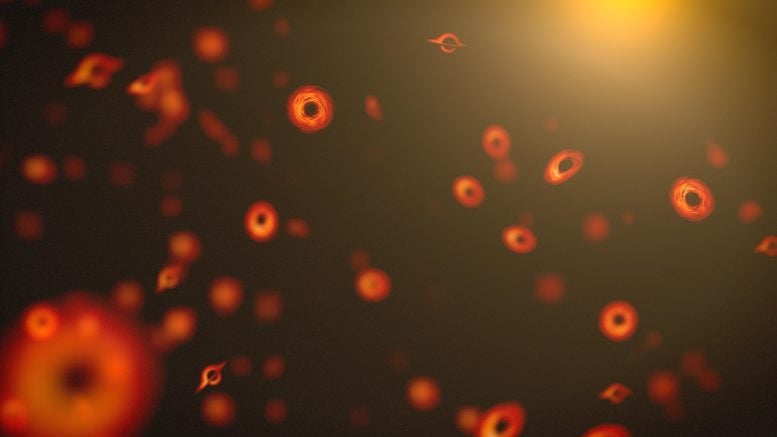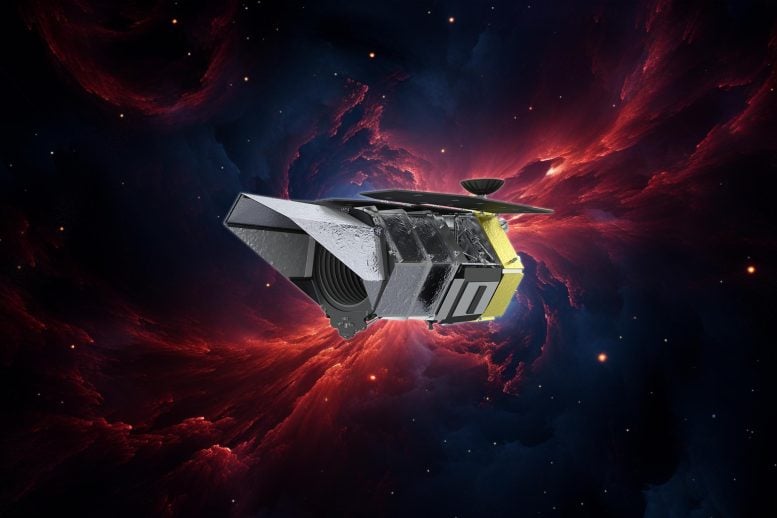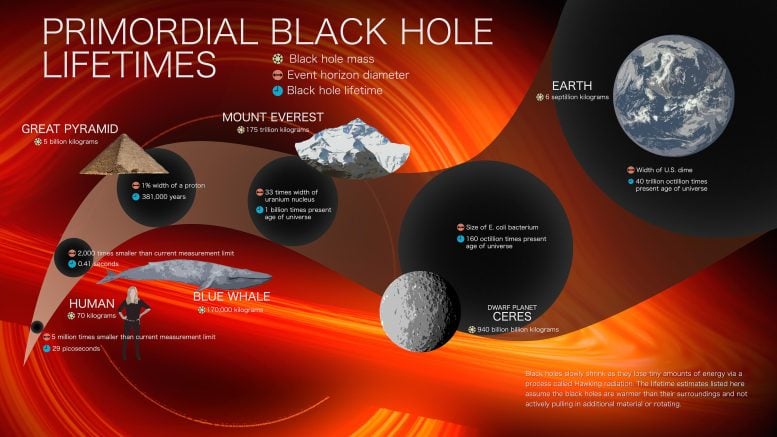
The next Roman Space Telescope could unveil a new class of “featherweight” black holes, challenging existing theories about black hole formation. These Earth-mass black holes, if discovered, could have significant implications for our knowledge of the early universe and the nature of dark matter. Credit: NASA Goddard Space Flight Center

The discovery of primordial, Earth-mass black holes with NASA’s Roman Space Telescope could transform our understanding of the universe and dark matter. Credit: NASA Goddard Space Flight Center
Primordial Black Hole Recipe
The smallest black holes that form today are born when a massive star runs out of fuel. Its outward pressure decreases as nuclear fusion subsides, so the inward gravitational pull wins the tug-of-war. The star contracts and can become so dense that it becomes a
” data-gt-translate-attributes=”({“attribute”:”data-cmtooltip”, “format”:”html”})” tabindex=”0″ role=”link”>black hole.
But there is a minimum mass required: at least eight times that of our Sun. Lighter stars will become either white dwarfs or neutron stars.
However, the conditions of the very early universe could have allowed the formation of much lighter black holes. A person weighing the mass of Earth would have an event horizon – the point of no return for falling objects – about as wide as a US dime.
As the universe was born, scientists believe it experienced a brief but intense phase known as inflation, during which space expanded faster than the speed of light. Under these particular conditions, areas denser than their surroundings could have collapsed to form low-mass primordial black holes.
While the theory predicts that the smallest ones would have to evaporate before the universe reached its current age, those with masses similar to Earth’s could have survived.
The discovery of these tiny objects would have a huge impact on physics and astronomy.
“It would affect everything from galaxy formation to the dark matter content of the universe to cosmic history,” said Kailash Sahu, an astronomer at the Space Telescope Science Institute in Baltimore, who was not involved in the study. ‘study. “Confirming their identity will be hard work and astronomers will need a lot of effort to convince them, but it would be worth it.”

Stephen Hawking hypothesized that black holes may slowly shrink as radiation escapes. The slow escape of what is now called Hawking radiation would, over time, simply cause the black hole to evaporate. This infographic shows the estimated lifetimes and event horizon –– the point beyond which falling objects cannot escape the gravitational grip of a black hole –– the diameters of black holes of various small masses. Credit: NASA Goddard Space Flight Center
Tips on Hidden Settlers
Observations have already revealed clues that such objects could be hiding in our galaxy. Primordial black holes are thought to be invisible, but ripples in space-time have helped identify some possible suspects.
Microlensing is an observational effect that occurs because the presence of mass distorts the fabric of space-time, like the imprint a bowling ball leaves when placed on a trampoline. Whenever an intervening object appears to drift near a background star from our vantage point, light from the star must pass through the distorted spacetime around the object. If the alignment is particularly close, the object can act as a natural lens, focusing and amplifying light from the background star.
Separate groups of astronomers using data from MOA (Microlensing Observations in Astrophysics) –– a collaboration that performs microlensing observations using the Mount John University Observatory in New Zealand –– and OGLE (Optical Gravitational Lensing Experiment) discovered a surprisingly large population of isolated Earth. -mass objects.
Theories of planet formation and evolution predict certain masses and abundances of rogue planets – worlds roaming the galaxy unrelated to a star. The MOA and OGLE observations suggest that there are more Earth-mass objects drifting across the galaxy than models predict.
This artist’s concept takes a whimsical approach to imagining small, primordial black holes. In reality, such small black holes would have difficulty forming the accretion disks that make them visible here. Credit: NASA Goddard Space Flight Center
“There is no way to distinguish Earth-mass black holes from rogue planets on a case-by-case basis,” DeRocco said. But scientists expect Roman to find 10 times more objects in this mass range than ground-based telescopes. “Roman will be extremely powerful in statistically differentiating the two.”
DeRocco led an effort to determine how many rogue planets should be in this mass range and how many primordial black holes Roman could discern among them.
The discovery of primordial black holes would reveal new information about the very early universes and strongly suggest that an early period of inflation did indeed occur. It could also explain a small percentage of the mysterious dark matter that scientists believe makes up most of the mass in our universe, but which they have been unable to identify until now.
“This is an exciting example of something that additional scientists could do with the data that Roman is already going to obtain during his search for planets,” Sahu said. “And the results are interesting whether or not scientists find evidence for the existence of Earth-mass black holes. Either way, it would strengthen our understanding of the universe.
Reference: “Revealing primordial land-mass black holes with the Nancy Grace Roman Space Telescope” by William DeRocco, Evan Frangipane, Nick Hamer, Stefano Profumo and Nolan Smyth, January 8, 2024, Physical examination D.
DOI: 10.1103/PhysRevD.109.023013
The Nancy Grace Roman Space Telescope is operated at NASA’s Goddard Space Flight Center in Greenbelt, Maryland, with participation from NASA’s Jet Propulsion Laboratory and Caltech/IPAC in Southern California, the Space Telescope Science Institute in Baltimore and a scientific team composed of scientists from various research establishments. Key industry partners include BAE Systems, Inc in Boulder, Colorado; L3Harris Technologies in Rochester, New York; and Teledyne Scientific & Imaging in Thousand Oaks, California.